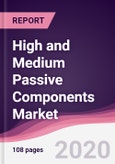What are High & Medium Passive Components?
A passive component is an electronic component which does not require an external source of energy to perform its function. The component itself is required to perform functions which are based on energy supply which is available within the system. The passive components are classified into high and medium passive components which depend on the temperature of the component and are used for managing or controlling the nature of power required by the passive component. For example, a capacitor does not require any external energy source to perform its function and will come into play to ensure that there is proper power distribution in the system.
The high and medium passive components are electronic components like chassis, inductor, resistor, transformer, or capacitor, filter, connector and so on. These components are used across a wide variety of products again ranging from smartphones to tablets to even medical devices.
What are the end-user industries of High & Medium Passive Components?
The high and medium passive components are used in a wide range of industry verticals ranging from consumer electronics, data processing, telecommunication, aerospace and defense, automotive and industrial and others. These components are used for various applications like smart phone, laptops, navigation systems, all types of vehicles, oil and gas, chemical and so on. There is a high demand for electronic goods and the continuing demand for passive components in various electronics products like smart watches, mobile phones, home appliances and others will propel the growth of the high and medium passive components market. The growth of the passive component market is carried out by incessant efforts from manufacturers and suppliers to deliver cheaper components. Therefore, the High and Medium Passive Component Market is a rapidly growing market with high use of passive components such as radio frequency (RF) components, microwave components and others in various end user industries for different applications across the globe.
Market Research and Market Trends of High & Medium Passive Components
The consumption of passive components by smartphone, particularly in thick film chip resistors and MLCC, is the most vital driving force behind innovation and consumption of passive components.
The major sellers of passive components have entered into a market environment where smartphones have a share of over 80% of unit output of phones; and this will drive the passive component market as smartphones require higher number of passive components for integration.
The advancement in the television market has resulted in the development of new and innovative products, like LED (Light Emitting Diode) TV, LCD TV and 4K television sets which are the next generation products that will please consumers at an affordable price. Hence, the market for the new generation TVs has the opportunity to grow based on the right combination of pricing and technology.
The rising use of smart wearables like smart watches and fitness trackers has formed a major trend to drive the passive components market.
Who are the Major Players in the High & Medium Passive Components market?
The companies referred to in the market research report include AVX, TDX, Panasonic, Samsung, Murata and others.
What is our report scope?
The report incorporates in-depth assessment of the competitive landscape, product market sizing, product benchmarking, market trends, product developments, financial analysis, strategic analysis and so on to gauge the impact forces and potential opportunities of the market. Apart from this the report also includes a study of major developments in the market such as product launches, agreements, acquisitions, collaborations, mergers and so on to comprehend the prevailing market dynamics at present and its impact during the forecast period 2020-2025.
Key Takeaways from this Report
- Evaluate market potential through analyzing growth rates (CAGR %), Volume (Units) and Value ($M) data given at country level – for product types, end use applications and by different industry verticals.
- Understand the different dynamics influencing the market – key driving factors, challenges and hidden opportunities.
- Get in-depth insights on your competitor performance – market shares, strategies, financial benchmarking, product benchmarking, SWOT and more.
- Analyze the sales and distribution channels across key geographies to improve top-line revenues.
- Understand the industry supply chain with a deep-dive on the value augmentation at each step, in order to optimize value and bring efficiencies in your processes.
- Get a quick outlook on the market entropy – M&A’s, deals, partnerships, product launches of all key players for the past 4 years.
- Evaluate the supply-demand gaps, import-export statistics and regulatory landscape for more than top 20 countries globally for the market.
Table of Contents
Methodology

LOADING...








